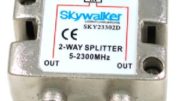Well… you can be patient. Right now DIRECTV only allows one 4K TV on the account with the HR54 Genie DVR, using a DIRECTV 4K Ready Smart TV or DIRECTV C61K 4K Genie Mini Client. It’s a technical limitation of the HR54 that it just doesn’t have enough power to serve more than one 4K stream at the same time.
DIRECTV’s Genie 2 DVR will support two 4K streams, but it still won’t support 3. That means you’re still limited, and while that’s not a huge deal considering that there isn’t a lot of 4K content on DIRECTV, it could become a huge deal as we move forward.
While the HR54 itself isn’t powerful enough to stream to more than one 4K device, it’s the limitation of the entire DIRECTV coaxial network that’s conspiring against you with 4K. Since DIRECTV’s 4K content uses the same MPEG-4 compression as its HD content, it takes up a lot of bandwidth. I’ve estimated 30-45 megabits per second may be a requirement for DIRECTV 4K, based on downloading their on-demand content. Considering that the coaxial network has a theoretical maximum of 175Mbps, supporting five HD streams at upwards of 12Mbps plus two4K streams at upwards of 45Mbps may just be maxing out the network.
While MoCA 1.1, the technology behind DIRECTV’s clients, can perform up to 175Mbps, it’s hard to say that DIRECTV’s implementation is actually that fast. Nothing ever does as well in the real world as it does in the lab, so that pretty much clinches it — it’s possible that three 4K streams could overload the network in some cases. So DIRECTV doesn’t allow it.
So what’s the answer? MoCA 2.0. This new technology is built into the HS17 Genie 2 DVR, so as soon as MoCA 2.0 clients are available, it’s possible the HS17 could support more than two 4K streams. No promises of course, and DIRECTV has pulled this before … making us believe that new software features would be rolled out to current hardware and then making us get new hardware instead.
In order to support seven 4K streams, you would need to have steady throughput, through wired or wireless connections, of upwards of 280Mbps. This isn’t impossible and in fact is quite easy to do with MoCA 2.0 and even with the wireless technology built into the HS17. So that part won’t be an issue as soon as we start seeing those clients that support the new standard.
For now, the HS17 is the only device approved for residential DIRECTV use that supports MoCA 2.0 at all. The only other one is a DECA adapter that’s used exclusively in hotels. But of course, things will change at some point. It’s just a matter of when. Until then, I suppose if you do go to all 4K TVs, you still have Netflix, YouTube and Amazon.




